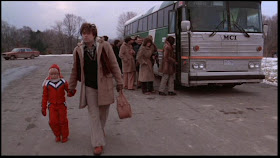(1979) Written and directed by David Cronenberg; Starring: Oliver
Reed, Samantha Eggar and Art Hindle; Available on DVD
Rating: ****
Perhaps no other director can depict being uncomfortable in
one’s own skin as effectively as David Cronenberg. In Cronenberg’s case, this isn’t simply a
metaphor but a physical reality – with all of the nasty implications that go
along. In many ways, The Brood is the archetypal Cronenberg
film, displaying many of the recurrent themes that he would refine and revisit
throughout the subsequent years. Mental
illness, bodily deformities, and physical transformation are all part of the
miasma that emerges from Cronenberg’s mind and infects our unconscious.
Oliver Reed plays Dr. Hal Raglan, a psychiatrist* with a new
radical therapy program, and author of the book The Shape of Rage. He has
established the Somafree Institute of Psychoplasmics, a residence facility
where he can conduct his experimental therapy in private. He’s developed a cult-like following among
his patients, who view him as a paternal figure. In an early scene he bullies one man to
regress into a childlike state. The patient
suffers a breakdown, which is seen as a breakthrough by his colleagues. But something else is occurring. The man’s anger takes on physical properties,
with numerous sores appearing over his body.
One of his star clients is Nola Carveth (played with over-the-top conviction
by Samantha Eggar). Of all of his
subjects, she exhibits the most extreme effects of her treatment. It becomes clear that she’s a means to an end
for Raglan and his novel therapy. It’s a
credit to Reed’s performance that Raglan remains three-dimensional, and not
entirely unsympathetic. He’s
narcissistic (as evidenced by the attention he diverts to his hair in one scene)
and self-serving, but he’s also aware of the psychological damage that Nola has
experienced. Raglan is unable to control
what he’s unleashed, but despite the consequences to Nola and others he’s
compelled to see it to the end.
* Cronenberg gets kudos for
actually making the distinction between psychiatrists and psychologists. Most filmmakers seem to use the labels
interchangeably – one of my pet peeves.
Nola’s ex-husband Frank (Art Hindle) takes a vested interest
in Nola’s treatment after he picks up his five-year-old daughter and notices
bruises on her back. When he attempts to
confront Nola about the abuse, Dr. Raglan stands in the way, claiming that Frank
would just hinder her recovery. Raglan’s
stonewalling only strengthens Frank’s resolve to take over custody of his
daughter, away from the influence of her disturbed mother.
(The next paragraph contains some spoilers. Read at your own
risk)
Anyone in Nola’s periphery becomes a potential threat, and
thus a target for her unbridled anger.
Her mother is the first to die a brutal death, at the hand of a vaguely
seen assailant. It slowly dawns on Frank
that the killer and its companions (which reminded me of a cross between the murderous
dwarf in Don’t Look Now, mixed with
the baby creature from It’s Alive)
are physical manifestations of her rage – monsters that spring from her unconscious. If you ever wondered what Forbidden Planet would look like if it
had been directed by David Cronenberg instead of Fred M. Wilcox, it might look
something like this. We get a
tantalizing peek into the humanoid creatures’ strange lifecycle after a doctor
performs an autopsy. We learn that the
creatures can only see things in black and white – a perfect reflection of Nola’s
current mental state. She appears to
suffer from borderline personality disorder, typified by regarding others in
terms of polarities, vacillating between love and intense hate. Frank is sheltered from her outbursts,
protected by her delusions of getting back together and restoring their family
unity.
This film was Cronenberg’s first collaboration with composer
and fellow Toronto native Howard Shore.
His somber, brooding score (I couldn’t resist) goes a long way to create
tension throughout the film, maintaining a relentless sense of unease. Shore has continued to work with Cronenberg
over the years, with his music a perfect match for his sensibilities
The Brood works on
multiple levels. It could be seen as an
extended metaphor for the dangers of over-dependency on therapy, or the
potential for ill effects inflicted by some of the less-than-ethical
practitioners that foster such dependency.
It could just as easily be regarded as a commentary on the damage left
in the wake of a failed marriage. The
characters and situations in The Brood were purportedly influenced by
Cronenberg’s real-life experiences with a messy divorce.
The Brood was well-acted
and disturbing – much better than I expected.
In less capable hands its premise about the physical manifestations of
rage would have been silly, but Cronenberg sells it. There’s a deliberate, measured buildup,
without showing too much of his hand too soon.
For most of its running time, the film is surprisingly restrained. The makeup effects are used sparingly, until
the truly disturbing, bloody climax. Cronenberg
seems to argue that mind and body are not distinct, mutually exclusive
entities, but inseparable. The Brood suggests
what we all might be capable of, given the proper stimuli, and implies what the
next, terrible stage of our evolution could look like.







This is another entertaining movie from Cronenberg (and Shore), but it seems rather misogynist to me. Four months earlier The Manitou also made women evil by making their reproductive bodies monstrous.
ReplyDeletePoint taken, although I think The Brood has some genuine thrills, while The Manitou is hard to take seriously. ... Of course the Manitou is entertaining for entirely different reasons.
ReplyDeleteI couldn't agree more, for which reason I love the Manitou. It's practically stupid. Perhaps Cronenberg's emotional involvement in the grotesquery of women is what made his movie so much less laughable and more visceral.
ReplyDeleteVery true. Visceral is the perfect word to describe Cronenberg's work in general. The Brood is much more stark and intimate, whereas The Manitou is cartoonish by comparison.
Delete